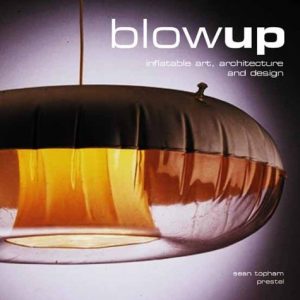
Blow-up: inflatable art, architecture and design
Sean Topham / Prestel, 2002
Sign.: RH 5.1 Top
This work explores the technological and philosophical history of inflatable art, architecture and design up to the present day, examining its presence in all aspects of life, from children’s toys to military craft. The author illustrates the countless uses of air-filled forms, revealing how inflatable objects still evoke the sense of optimism and escape that inspired the first designers in this field, the 18th-century inventors of the hot-air balloon. The author argues that, although inflatable forms have been around for centuries, scientists, architects, artists and manufacturers keep rediscovering this deceptively simple technology. He explains how some of its first applications were extreme environments, where it appealed to scientists and the military. But in the 1960s, artists such as Andy Warhol and Claes Oldenburg, and design collectives such as Utopie and Archigram, used pneumatic forms to challenge conventional assumptions about the role of materials in art and architecture. Contemporary designers such as Verner Panton and Issey Miyake have incorporated blow-ups into their work, and today inflatables have entered the mainstream market in such diverse structures as toys, furniture and walk-through environments. The artists featured in the book include: Victor Lundy; Hans-Walter Mueller; Otto Frei; Yayoi Kusama; Christo; Claes Oldenburg; Jeffrey Shaw; Lygia Clark; Takashi Murakami; Takahiro Fujiwara; Philippe Parreno; Andy Warhol; Issey Miyake; Archigram; Walter Bird; AJS Aerolande; Francisco de Goya; Haus Rucker; Quasar Khan; Nicholas Grimshaw; and Verner Panton.
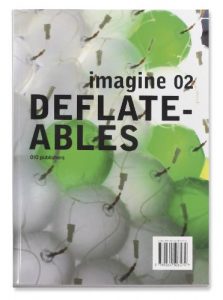
Deflateables
Ulrich Knaack, Tillmann Klein, Marcel Bilow / 010 Publ., 2008
Sign.: PH 8 Kna
Pneumatic structures were developed during the 1960s. However, the energy crisis and aesthetic developments impeded the use of these structures as a mainstream construction method. Nowadays, they are typically used in special areas of architecture and design. Deflateables concentrates on the limited knowledge of vacuum constructions and develops a range of aesthetic, technical and functional design possibilities. Very few designs that use pressurized constructions have actually been realized, even today, despite the fact that this technology offers simple, positive aspects: the air pressure of the earth can be used as a stabilizing and form-giving parameter, creating a specific and inspiring shape. In addition, the very nature of this technology provides varying degrees of thermal and acoustic insulation. Of course, it has its weaknesses, such as potential leakage and the need for high pressurization of the construction; but new material technologies and specific structural concepts can bring solutions to such issues. Exploiting the possibilities of extremely light and energetically active constructions, deflateables are one of the promising fields of architectural and design developments. The chance to create structures that can move and react to requests such as user and climate requirements as well as formative demands lifts this topic onto the level of a realistic and usable technology for as-yet-unknown design possibilities.
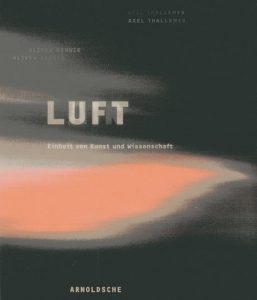
Air: unity of art and science
Oliver Herwig, Axel Thallemer / Arnoldsche Art Publ., 2005
Sign.: HG 4 Her
What is air? You don’t think about air or even perceive it unless it has changed from its usual state. Air, that most ubiquitous of the four elements, was long the most inexplicable enigma, peopled by gods and their messengers, venerated as the abode of spirits or demons. Nowadays air has been ‚deconsecrated‘ and almost entirely demystified by science. Its availability is crucial; it envelops us and our planet – allows us to breathe and is anything but something to be taken for granted. The book addresses the question of what air is and approaches answering it from two angles. First, through a scientific explanation of its chemical and physical elements, their properties and the effect they have on our immediate environment. In parallel, air is traced as a phenomenon dealt with in art, architecture and design, all of which perceive, represent and creatively use air as a medium in entirely different ways. The focus is on the twentieth century to the present day. The juxtaposition of art, architecture, design, and science generates an exciting dialogue on air.
An imaginative experiment intended to stimulate all those who are seriously concerned about air as an element vital to our survival.
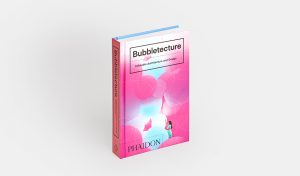
Bubbletecture: inflatable architecture and design
Sharon Francis / Phaidon, 2019
Sign.: RG 1 Fra
Although inflatable objects have been around for more than 200 years, architects, artists, and designers keep rediscovering this deceptively simple – often playful, and occasionally bizarre – technology.
Bubbletecture brings together inflatables in every conceivable size, shape, and hue across the realms of architecture, design, art, and fashion. From inflatable dresses and hats to buildings employing cutting-edge technologies, from ingenious chairs, lights, bowls, and even egg cups to children’s toys and provocative art installations, Bubbletecture demonstrates that inflatable design is simply irresistible.
Architects featured include OMA (Rem Koolhaas), BIG (Bjarke Ingels), and Arata Isozaki, and design stars such as Snarkitecture. It includes work by cutting edge artists such Yayoi Kusama, Christo, and Anish Kapoor and by well-known fashion-designers such as Balenciaga, Yohji Yamamoto, Comme des Garçons, and many more.
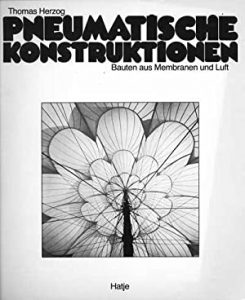
Pneumatische Konstruktionen: Bauten aus Membranen und Luft
Thomas Herzog / Hatje, 1976
Sign.: PH 7 Her
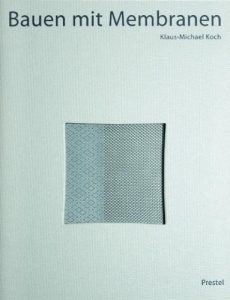
Bauen mit Membranen: der innovative Werkstoff in der Architektur
Klaus-Michael Koch. / Prestel, 2004
Sign.: PH 2 Bau
Dieser Band über Membranen, dem sog. fünften Baustoff, liefert Fakten zu den zahlreichen Neuerungen auf dem Sektor der Materialentwicklung, der Anwendungstechnik sowie der vielfältigen gestalterischen Formen in der Architektur. Praxisorientierte Fachautoren legen Grundinformationen des Membranbaus dar: Geschichte, Materialien und Verarbeitung, Primärtragwerke für Membranbauten, Technik der Membrankonstruktionen, Regeldetails und Montage. Ein umfangreicher Projektteil führt an aktuellen Beispielen die Nutzungsmöglichkeiten wie auch die Leistungsfähigkeit dieser Konstruktionen vor.
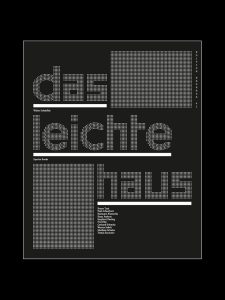
Das leichte Haus: Utopie und Realität der Membranarchitektur
Walter Scheiffele / Spector Books, 2015
Sign.: PH 2 Sch
Ausgangspunk der fundierten Untersuchung von Walter Scheiffele ist das 1926 veröffentlichte Buch „Der Raum als Membran“. In ihm hatte Siegfried Ebeling seine Theorie der biologischen Architektur entwickelt. Auch wenn er von vielen Bauhaus-Architekten aufmerksam gelesen wurde, geriet Ebelings Werk schnell in Vergessenheit. Walter Scheiffeles großangelegter Essay bezeugt nun die die Genese einer nach wie vor virulenten Idee. Denn mit Ebeling lässt sich ein Bezug zur utopischen Architektur, der scheinbar am Bauhaus in Dessau verloren ging, wieder herstellen. Über sein Werk lassen sich die phantastischen Entwürfe der Gläsernen Kette mit den Metallhausplänen eines Hugo Junkers über die Membranarchitekturen von Frei Otto bis Werner Sobek bis zum Klima-Engineering von Matthias Schuler in der Gegenwart verbinden. Ebeling blieb seinen utopischen Projekten in der Nachkriegszeit treu; an der bundesdeutschen Realität ist er damit jedoch gescheitert. Es ist an der Zeit, ihn wieder zu entdecken – und mit ihm eine bedeutende Linie der utopischen Architektur.
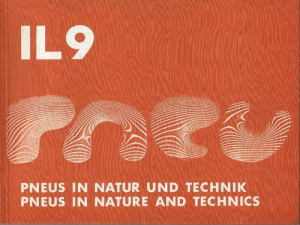
Pneus in Natur und Technik / Eda Schaur… [Hrsg.].
Institut für Leichte Flächentragwerke (IL)
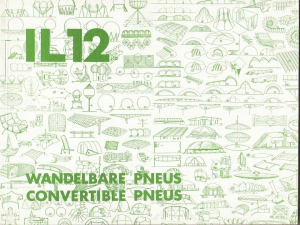
Wandelbare Pneus / Autoren: Ewald Bubner …
Mitw. Institutionen und Firmen: Entwicklungsstätte für d. Leichtbau, Atelier Warmbronn
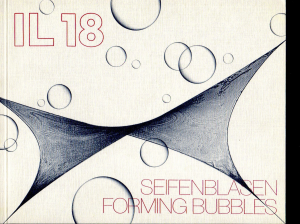
Seifenblasen : eine Forschungsarbeit des Instituts für Leichte Flächentragwerke über Minimalflächen / Red. : Klaus Bach. Frei Otto [Bearb.]. Institut für Leichte Flächentragwerke (IL), Universität Stuttgart
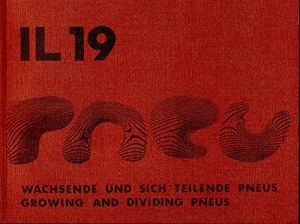
Wachsende und sich teilende Pneus / Cornelius Thywissen [Bearb.]
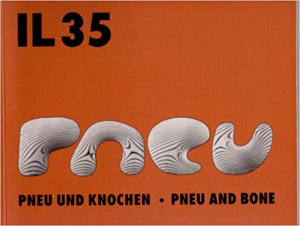
Pneu und Knochen / Frei Otto. Institut für Leichte Flächentragwerke (IL),
Universität Stuttgart. [Übers.: A. N. Kreuser]
Sämtliche Schriften des Instituts für leichte Flächentragwerke sind im Hand-Apparat bei Prof. Klaus Michel
und können dort zu Beginn des Semester im Oktober eingesehen oder ggfs. ausgeliehen werden!
Die IL-Mitteilungen wurden vom ehemaligen Institut für Leichte Flächentragwerke unter der Leitung von Prof. Frei Otto herausgegeben. Jedes Buch ist einem anderen fundamentalen Thema des Leichtbaus gewidmet und stellen essentielle Bausteine des Architektur- und Ingenieurwissens dar.